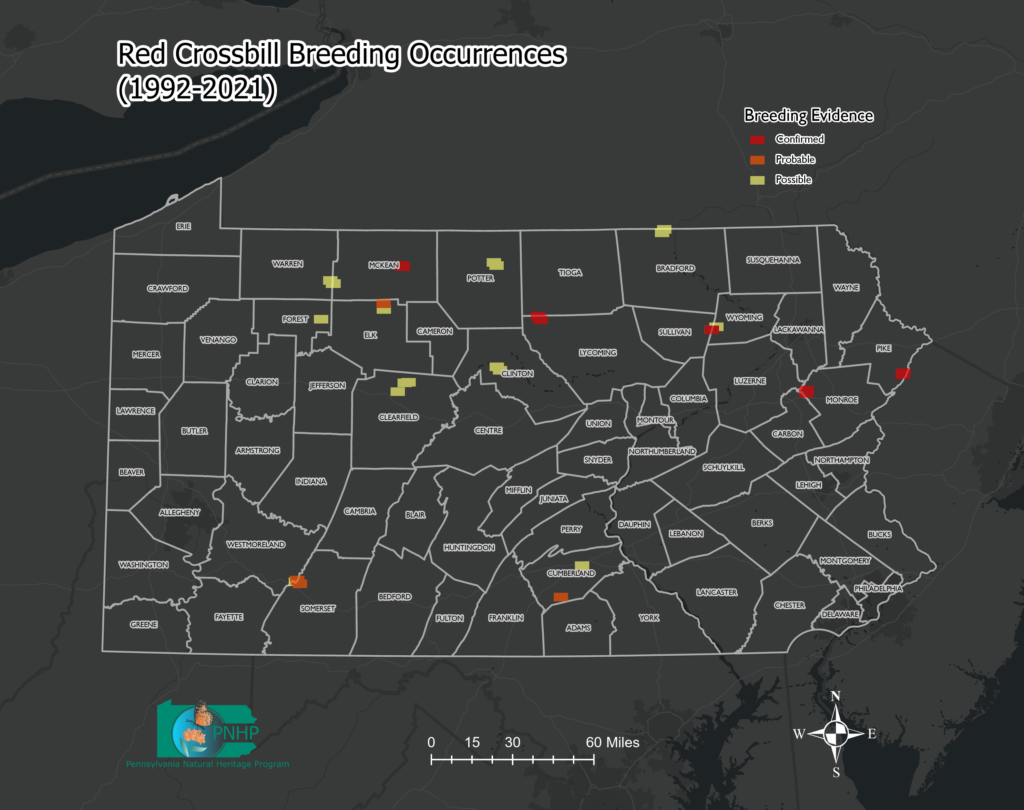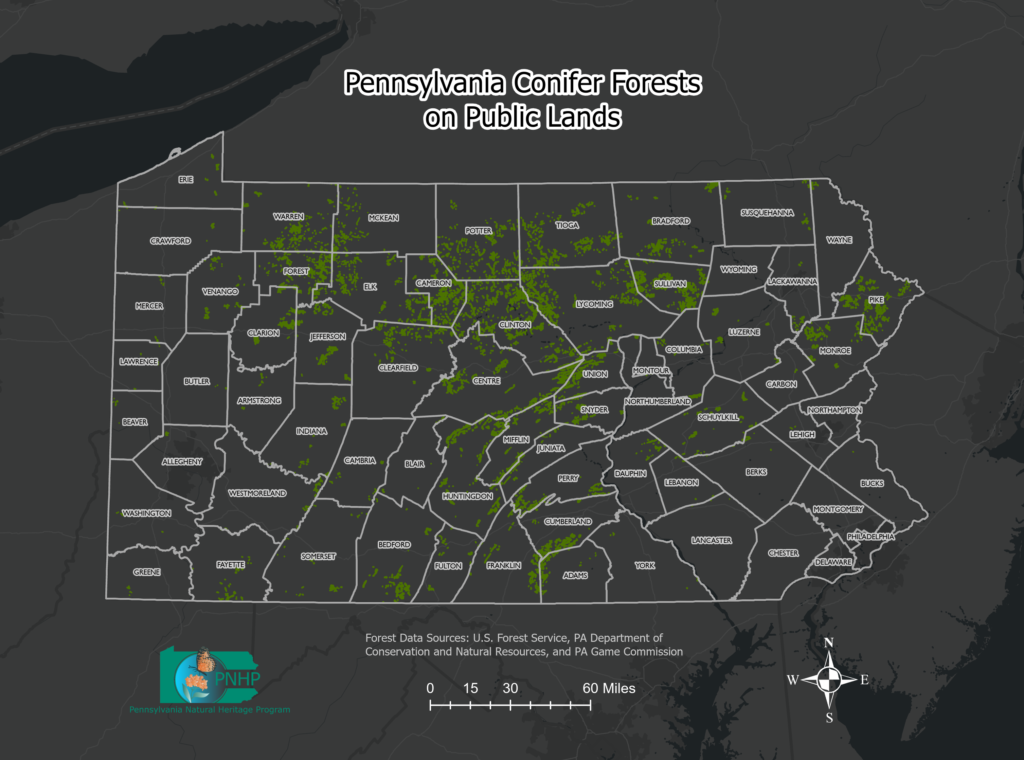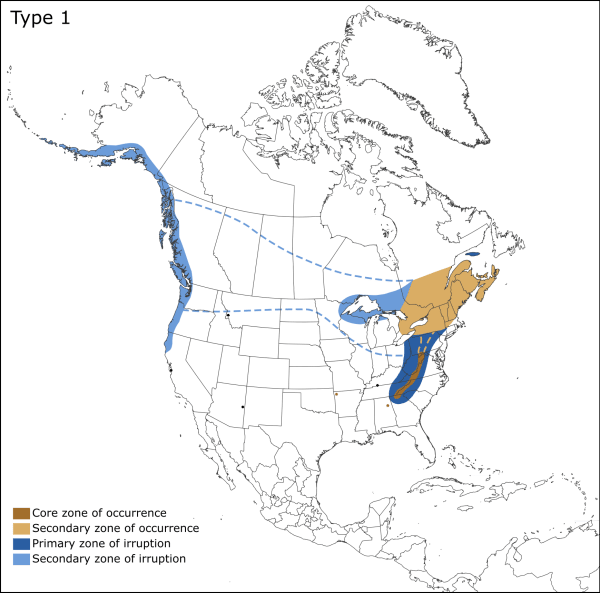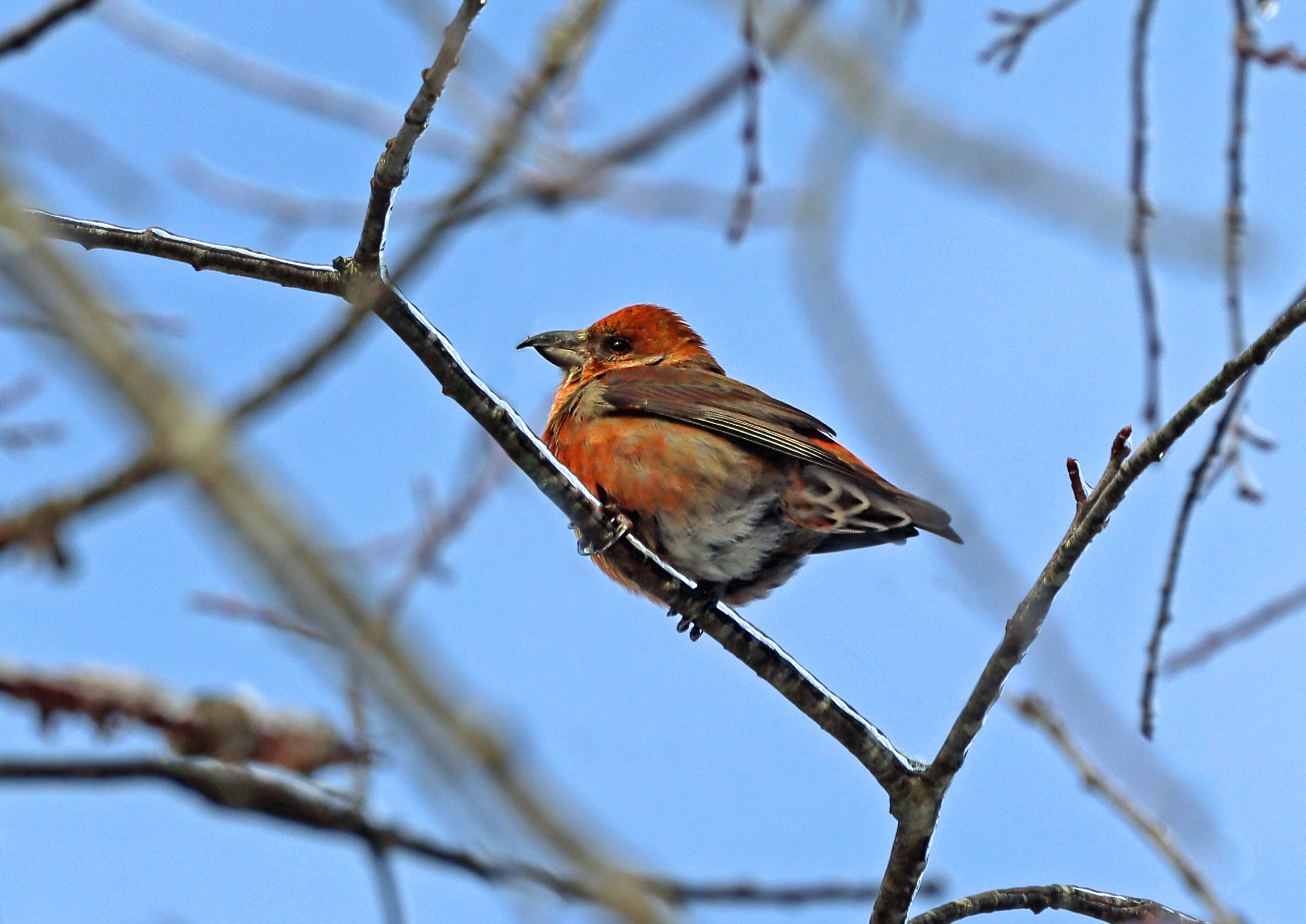Surveying for Red Crossbills in Pennsylvania and Beyond
David Yeany II, Avian Ecologist, Pennsylvania Natural Heritage Program
Matthew Young, President, Finch Research Network
A beautiful, yet strange and nomadic bird, the crossbill is akin to a cold-weather parrot – often hanging upside down on spruce cones, dangling about. All the while that crossbill is using a highly specialized bill to extract its seed from the cone. Two species of crossbills occur in Pennsylvania – White-winged Crossbill (Loxia leucoptera) and Red Crossbill (Loxia curvirostra). Both crossbills are irruptive finches, finding their way into Pennsylvania when cone crops are abundant here and sparse in other parts of their range. As the name indicates, crossbills do indeed have crossed mandibles which evolved as a mechanism allowing them the leverage to open cones packed with seeds from spruces, hemlocks, pines, and other conifers.
In Pennsylvania, Red Crossbill is a Species of Greatest Conservation Need (SGCN) and is a recently added tracked species by the Pennsylvania Natural Heritage Program (PNHP). Loss of conifer forests in the northeastern U.S. likely led to historic declines. Loss of conifer forest remains a concern with continued logging, resource extraction, and pests like the Hemlock Wooly Adelgid. Not to mention waning conifer regeneration and fire suppression have led to declining native conifer stands.
Breeding occurrences are very sparse in Pennsylvania and known from Bradford, Clearfield, Clinton, Forest, Lycoming, McKean, Monroe, Pike, Potter, Somerset, and Wyoming counties. The First Atlas of Breeding Birds in Pennsylvania had just six “Possible” breeding occurrences, while the Second Atlas of Breeding Birds had 11 occurrences – six “Possible”, one “Probable”, and four “Confirmed”. Data compiled by PNHP show 34 breeding occurrences for Red Crossbill in Pennsylvania over the past 30 years (Figure 1). Red Crossbills will very often nest during atypical breeding season compared to most other songbirds – January to April in response to the previous year’s cone crop and July-August in response to the newly developed cone crop. This leaves them as an extremely under-surveyed bird species.

Figure 1. Red Crossbill occurrences in Pennsylvania (1992-2021), compiled by PNHP, including data from 2nd Breeding Bird Atlas and eBird as well as other sources.
We can use your help in documenting “Probable” and “Confirmed” breeding attempts by Red Crossbills this year in Pennsylvania. There has been a modest irruption of Red Crossbills into the state this winter with observation in Clearfield, Elk, Forest, Luzerne, Monroe, and Tioga counties. Finding crossbills can be tricky, but they are most often detected by their distinctive kip-kip-kip or jip-jip-jip flight calls as the fly overhead. More on flight calls in a bit.
Red Crossbill (Appalachian or Type 1) flight call: https://macaulaylibrary.org/asset/137497
But if one finds a feeding flock high up in conifers, they can be quite noisy, giving their flight calls, toop notes, and perhaps even singing.
Red Crossbill (Appalachian or Type 1) territorial song: https://macaulaylibrary.org/asset/138310
They also can be found gritting for salt and stones on the road – a behavior that can lead to considerable mortality within a flock of crossbills. The place to begin searching for Red Crossbills this winter are conifer stands – red spruce, white spruce, Norway spruce, red pine, white pine, pitch pine, Virginia pine, scots pine, and Eastern hemlock. See Figure 2 for locations with conifer cover in Pennsylvania. Focus on conifer stands with substantial cone crops. For example, this winter Norway spruce seems to have an excellent cone crop and has been a habitat where Red Crossbills have been found.

Figure 2. Conifer forest cover, both plantation and natural, across large public lands in Pennsylvania, including State Forest, State Game Lands, and Allegheny National Forest., compiled by PNHP, including data from 2nd Breeding Bird Atlas and eBird as well as other sources.
Check out this blog article by Finch Research Network for more tips on locating breeding Red Crossbills: https://finchnetwork.org/how-to-search-for-breeding-crossbills
Crossbill species identification can be fairly straightforward with White-winged Crossbills having one or two bold white wing bars or patches, while Red Crossbills lack these white wing bars. Females are generally olive-green or green-yellow with darker brown-black wings, and a pale gray to white throat – a key characteristic to distinguish females from immatures or confusing plumaged males. Adult males are typically brick red bodied with black/blackish brown wings. Some immature males may look greenish like females, adults, or a mix of red and green. Juvenile Red Crossbills have brown streaked bodies on a cream/whitish base with brown wings which can sometimes show two prominent buffy wing bars and bills are not fully crossed until 30 days after hatching. So, beware of confusing these juveniles with female House Finches!
Now for Red Crossbill call Types! Currently Red Crossbill exists as a species complex of 10 or more call Types which correlate with populations that have distinct ecological niches, genetics, and morphology. These populations can be identified via spectrogram, and for some by ear, to specific call Type. Recently one of these call Types was elevated to full species status, Cassia Crossbill, and others may be cryptic species as well. Matt Young at Finch Research Network coordinates efforts to identify and map call Types as well as investigations of emerging evidence for speciation with the Red Crossbill complex.
In Pennsylvania, there have been four Red Crossbill Types documented:
- Type 1 – Appalachian (Medium-billed)
- Type 2 – Ponderosa Pine (Large-billed)
- Type 3 – Western Hemlock (Small-billed)
- Type 10 – Sitka Spruce (Small-billed to medium-billed)
The Appalachian (Type 1) Red Crossbill has its core zone of occurrence in the southern Appalachian Mountains with overlapping secondary occurrence and primary irruption zones in Pennsylvania (Figure 1). This is the most-expected Red Crossbill Type to breed in Pennsylvania. Since there have been a few records of potential breeding Type 10 in the last month as well, birders and ornithologists should be on the lookout for this Type in Pennsylvania. It would be a state first if Type 10 was confirmed breeding. However, more documentation through audio recordings of flight calls and breeding observations is needed to better understand Red Crossbill distribution in Pennsylvania and better conserve the species.

Figure 2. Red Crossbill Type 1 – Appalachian range map (Ken McEnaney).
For a deeper dive into Red Crossbill Types, check out this article by Finch Research Network: https://finchnetwork.org/species/crossbills/red-crossbill-loxia
Also, if you live outside of Pennsylvania (as many of you might!), these survey methods should apply to anywhere in the northeastern U.S. For example, New York is currently seeking Red Crossbill breeding observations for their 3rd Breeding Bird Atlas: https://ebird.org/ebird/atlasny/news/species-spotlight-red-crossbill
Here’s how to help document breeding Red Crossbills this year in Pennsylvania. Survey for Red Crossbills this January through April and then again in July and August in conifer stands across the state. Follow the survey protocol below and send observations to PNHP at dyeany@paconserve.org.
PNHP Red Crossbill Survey Protocol
- Timing: Territories begin early January. Peak breeding is February – April and July – August.
- Record date and time (e.g. 12 January 2022, 0800)
- Observers: Record observer names.
- Location: At minimum, record latitude and longitude of observation in decimal degrees (e.g. 42.83451, -78.12345). If possible, record track of your survey if traveling.
- Assess cone crop:
- Record conifer tree species: Norway spruce, white spruce, red spruce, red pine, Virginia pine, pitch pine, white pine, Eastern hemlock, tamarack, European larch
- Record cone crop abundance: None, Very Poor, Poor, Average/Fair, Good, Excellent, Bumper
- Record breeding behavior:
- Are birds traveling as MALE/FEMALE pairs?
- Separate females from immature birds: Females must have a PALE THROAT.
- Female is uniformly olive to grayish with greenish or greenish yellow breast and rump; typically, with pale grayish to whitish throat, which may be more or less mottled
- Look for courtship and pair bonding behaviors such as bill-touching and food exchanges
- Are birds singing repetitive song phrases? Stereotypical phrased songs indicate territorial crossbills. Here is an example of Red Crossbill (Appalachian Type1) territorial song: https://macaulaylibrary.org/asset/138310
- Listen for chitoo calls from young crossbills begging to be fed by adults. Here is an example of Red Crossbill begging calls: https://macaulaylibrary.org/asset/241312111
- Record acceptable breeding codes for Red Crossbills:
- S Singing Bird (Possible) — Singing bird present in suitable nesting habitat
- S7 Singing Bird Present 7+ Days (Probable) — Use only if you have observed a singing bird at the same spot (not elsewhere) one week or more, earlier in the season.
- P Pair in Suitable Habitat (Probable) — Pair observed in suitable breeding habitat with courtship/pair bonding behavior and/or moving together.
- CN Carrying Nesting Material (Confirmed/Probable) — Adult carrying nesting material; nest site not
- NB Nest Building (Confirmed/Probable) — Nest building at apparent nest site.
- CF Carrying Food (Confirmed) — Adult carrying food for young.
- ON Occupied Nest (Confirmed) — Occupied nest presumed by parent entering and remaining, exchanging incubation duties, etc.
- NE Nest with Eggs (Confirmed) — Nest with eggs.
- NY Nest with Young (Confirmed) — Nest with young seen or heard.
- FY Feeding Young (Confirmed) — Adult feeding young that have left the nest, but are not yet flying and independent
- FL Recently Fledged Young (Confirmed) — Recently fledged or downy young observed while still dependent upon adults.
- Are birds traveling as MALE/FEMALE pairs?
- Audio and Photo Documentation:
- Try to obtain audio recordings with smartphone or other audio recording device, if crossbills vocalize.
- Try to obtain photos if birds are observed visually.
- Submit Observations:
- Email observations to David Yeany II, Avian Ecologist, PA Natural Heritage Program at dyeany@paconserve.org
- Submit observations to www.eBird.org along with audio recordings to help build the library of Red Crossbill Types documented in Pennsylvania.
David Yeany II is the Avian Ecologist for the Pennsylvania Natural Heritage Program (PNHP) at the Western Pennsylvania Conservancy. David joined PNHP in 2011 and has 17 years of professional experience in ornithology and bird conservation. He has a M.S. in Applied Ecology and Conservation Biology from Frostburg State University and B.S. in Biology from Messiah University. His work includes avian ecology and monitoring; wildlife-habitat relationship studies; rare and endangered species surveys; spatial analysis in GIS; conservation projects for Species of Greatest Conservation Need (SGCN); and tracking studies of wintering Evening Grosbeaks with new technologies. Yeany represents the Natural Heritage Program on the Pennsylvania Biological Survey (PABS) Ornithological Technical Committee and is Chair of the Pennsylvania Ornithological Records Committee (PORC).
FiRN is a nonprofit, and has been granted 501c3 status. FiRN is committed to researching and protecting these birds and threatened finch species like the Evening Grosbeak, a species that has declined 92% since 1970. We are actively in the process of fundraising around an Evening Grosbeak Road to Recovery plan in addition to a student research project, so please think about supporting our efforts and making a small donation at the donate link below.

